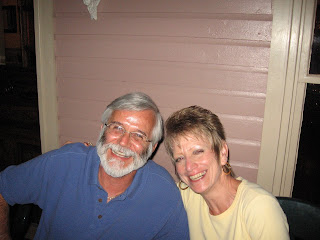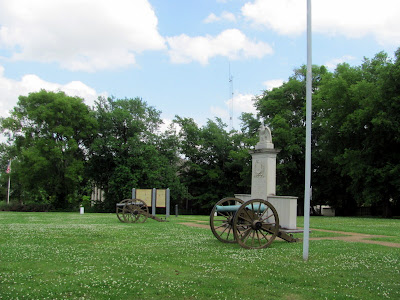We moved up the river to Vicksburg to explore another little river town and the Civil War battlefield. The battle for Vicksburg with its location on the Mississippi was considered by Lincoln to be the key for winning the war. Union control of the town and river would cut the Confederate states in half and restore the Union supply lines in the West. The battle took place over three months and included battles in Port Gibson (last post) and the capture of Jackson. In Vicksburg it became a 47 day siege with the town surrounded by Union troops to the East and the river to the West.
Vicksburg National Military Park with a driving route along the Union and Confederate lines has all the usual artillery and many memorials honoring those who fought here.
The Shirley House is the only war time building still standing in the park. It was used as the headquarters by the 45th Illinois infantry. You can still see the trenches that were dug to protect the soldiers.
The Illinois Memorial has 47 steps, one for each day of the siege, and lists the names of the more than 30,000 Illinoisans who fought here. Look what Nanc found. J. B. Tidball served here. I wonder if he was related to me or Lanny from Grand Isle?
A few of the memorials. Top left is a Wisconsin memorial. Center is one dedicated to the Black troops who served here, proving they would fight with valor. By the end of the war over 200,000 where serving. Top right is the Pennsylvania memorial. Bottom right is a modern Kansas memorial, one of several that honors soldiers from the states who fought on sides. Bottom left is a Confederate memorial.
Looking from the Union lines to the Confederate lines. Grant used a siege because the South was so well dug in that frontal attacks proved to be hopeless. The hilly terrain made movement very difficult. The siege was successful in weakening the Confederates to the point that they surrendered on July 4, 1863, 150 years ago. An interesting note is that in the 1880's the river changed course and no longer flows through the area where it did during the siege.
Nanc in one of the trenches. The Union troops had access to supplies so their situation was much better than the Southern troops who were trapped in the city. The fall of Vicksburg and the defeat of Lee at Gettysburg at the same time was the turning point of the war even though it lasted for almost two more years.
During the siege Orion P. Howe, a 14 year old Union musician, was wounded when he volunteered to deliver a message that troops needed more ammunition. Despite his wounds he got the message to General Sherman, thus becoming the youngest soldier to ever win the Medal of Honor, our nations highest award.
One of the neatest things in the park is the USS Cairo, a Union ironclad that was sunk in the Yazoo River during the siege. It was the first ship ever sunk by an electronic mine. It was on the bottom of the river until it was raise in the 1950's.
The model shows how the ship originally looked. Bottom is the device used to raise the anchor, middle are the steam boilers, right are the huge pistons that turned the paddle wheel.
Because the ship sank so quickly, with all men escaping safely, many artifact have been found at the site. It is amazing to see this ship that was the most advanced ship during the war. These ships played a major role in the siege by firing on the city from the river.
One of the newer monuments is from Kentucky where both Presidents Lincoln and Davis were born. Kentucky stayed in the Union and had many soldiers fighting on both sides.
Vicksburg is also the home of the
Lower Mississippi River Museum with many displays of the Army Corps of Engineers' role in controlling the river. Above is a model of 70 miles of the river and the levees that control it. The M/V Mississippi IV, an old Corps boat, is also on display.
The self guided tour of the ship is very cool..
Displays showing how the river has changed from the time of the Indians, to the flat boats and then the steamboats. There is also a display on the devastating 1927 flood that covered over 27,000 square miles and took eight months to recede. That flood lead to many changes along the river including higher levees and removing meanders from the river. This shortened the river by over 100 miles.
Vicksburg is also the first place where Coca-Cola was bottled. They have an interesting display of Coke memorabilia including the original bottling machines, many cans and bottles and an old soda fountain. Top left is the original coke float. Ice cream was put in the "float" and you drank the soda through the ice cream.
On the wall along the waterfront are murals of Vicksburg's history. Top is the Teddy Roosevelt bear hunt where the idea for the Teddy Bear originated. Bottom are the ironclad gun boats steaming down the river to deliver supplies to Grant. Left is Nanc showing the height of the floods over the years. Vicksburg is a neat little river town with an interesting history.

























































